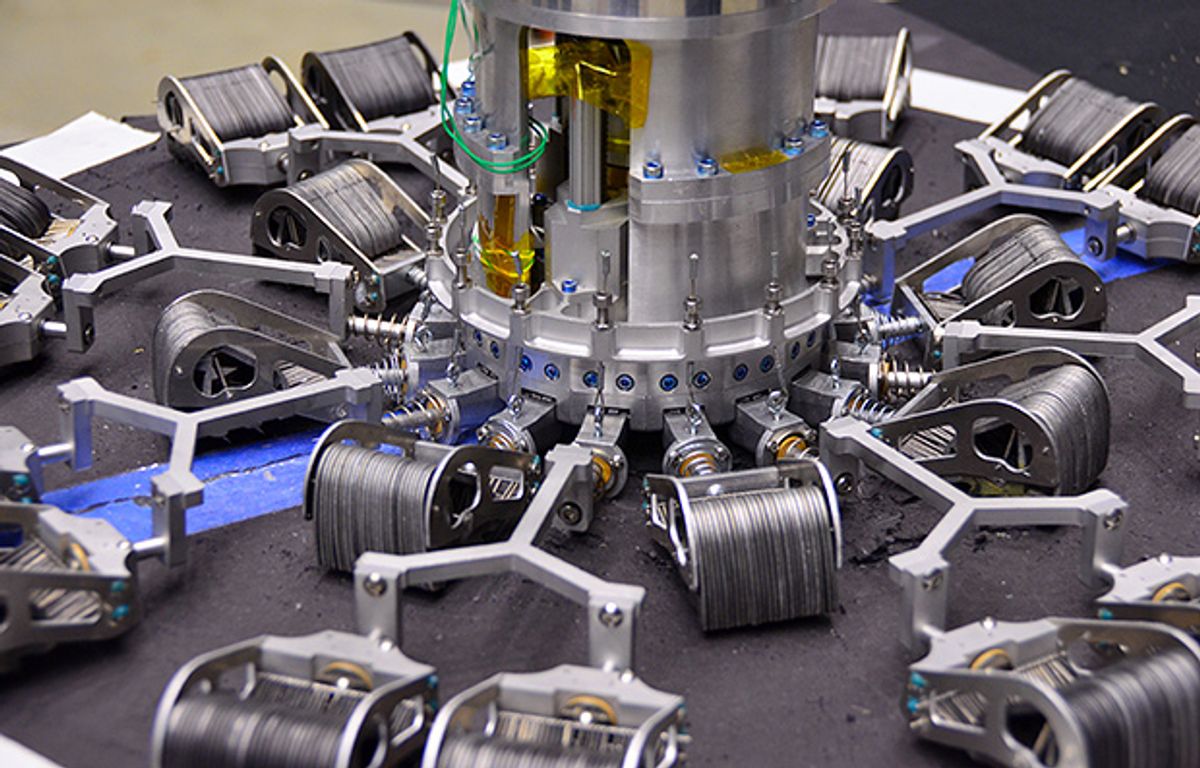Within the next five years, NASA is planning to launch a robotic spacecraft toward a small asteroid. Once there, the robot will find a small boulder lying on the surface of the asteroid, pick it up, and bring it back to Earth for us to have a look at. It’s an ambitious mission, and we’re only just starting to hear details about what’s going to be involved in getting all this to work.
Earlier this week, we stopped by NASA’s Goddard Space Flight Center in Greenbelt, Md., to check out some of the prototype hardware that’ll be grabbing a boulder off of an asteroid in the early 2020s.
We’ve got a beefy post from just a few months ago detailing the Asteroid Redirect Mission, but here’s a video from NASA summarizing the important robotic stuff:
See those long, articulated arms? At NASA Goddard, we got a peek at some development prototypes. Here’s the arm:
It was all folded up when we saw it; the bigger joint on the right is the shoulder; the joint in the middle is the elbow; and the smaller joint at the front is the wrist. Here’s a rapid prototyped model of the arm in its extended position to give you a sense of scale:
So that’s pretty cool, but the really exciting part is the gripper that’ll do the actual microgravity boulder-grabbing. Check it out:
This is a microspine-based gripping system: each one of those “toes” is made up of a big pack of individually sprung flexible bits of metal, and each of those has three tiny metal claws on it:
In total, that’s over 2,000 individual spines on this one gripper. Since each trio of spines can flex independently of all the others, it’s perfect for grabbing on to rough surfaces. And you don’t need every single spine to get a good grip: if just a fraction of them get a good hold, you’re fine, especially when gravity is close to zilch.
The gripper functions by resting itself on the surface that it needs to grab onto, and then cables that run from each toe up inside the central hub start to tighten, pulling the toes inward and causing the spines to engage with the surface. To release, the cables loosen, disengaging the spines. Neither engagement nor disengagement requires any force to be pushing the gripper towards the surface, which is why it’s ideal for microgravity.
NASA hasn’t finalized the designs of the gripper, and they may decide to switch up the structure and placement of the toes. They’re also experimenting with other toes that are more compliant, like this version where every single spine can move independently:
What’s especially cool about this microspine gripper design is that we’ve been following it for over a decade. In 2006, Sangbae Kim (who is now at MIT working on a Cheetah robot) presented a paper at ICRA on Spinybot, “the first climbing robot that uses micro claws to produce adhesion on a surface.” Specifically, Spinybot (based on Stanford research into microspines going back to at least 2004) was the first application of the idea that you can use a lot of individually compliant toes with small spines on them to adaptively conform to a surface and collaboratively support the weight of a robot:
Most of the technology in Spinybot was quickly transferred to RiSE, a more robust climbing robot built by Boston Dynamics:
At some point, JPL began working on a gripper based on this microspine technology, and in 2012 and 2013, Aaron Parness (who was working with Sangbae Kim at Stanford on microspines) presented papers at ICRA and IROS detailing a gripper design intended to help probes stick to asteroids in microgravity, and then the application of four grippers on a climbing robot:
And after that, NASA was like, “hey, cool, we need one of those,” and adapted the technology for the asteroid redirect mission.
Again, we should emphasize that none of this hardware is finalized. It’s all prototypes that NASA is using to figure out what works, and what doesn’t. The 2020 launch date isn’t that far away, though, so we’re expecting to see some additional iterations show up fairly quickly. Goddard is in the process of opening a brand new lab for space exploration and satellite servicing called the Cauldron, and we’ll definitely be heading back there to check things out as the mission prep progresses.
[ NASA Asteroid Redirect Mission ]
Evan Ackerman is a senior editor at IEEE Spectrum. Since 2007, he has written over 6,000 articles on robotics and technology. He has a degree in Martian geology and is excellent at playing bagpipes.









